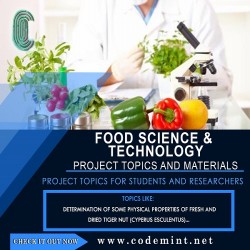- The Complete Research Material is averagely 44 pages long and it is in Ms Word Format, it has 1-5 Chapters.
- Major Attributes are Abstract, All Chapters, Figures, Appendix, References.
- Study Level: BTech, BSc, BEng, BA, HND, ND or NCE.
- Full Access Fee: ₦6,000
Get the complete project »

ABSTRACT
This project was aimed at assessing the prevalence of Gestational diabetes among pregnant women attending Yusuf Dantsoho Memorial Hospital Tudun Wada Kaduna (Y.D.M.H) Kaduna state. Simple random techniques was administer to generate information on socio-economic characteristics and on their prevalence of gestational diabetes. The findings of the 19-24 (53.66%). 65.09% of them were full time house wives with low level of education (12.19%) and low level of income 4.88% among the pregnant women attending Yusuf Dantsoho Memorial Hospital Kaduna (Y.D.M.H). Base on this research. The researcher may attempts to recommend that moderate exercise, good eating habit and frequently attending of antenatal clinic for better monitoring of glucose level and well-being of the pregnancy and the pregnant women.
CHAPTER ONE
1.0 INTRODUCTION
Diabetes can be defined as a spectrum and acquire metabolic disaster by an inadequate supply of effective insulin or the ability of the body to uti.ize insulin, a hormone produced by beta cells of lagartian in the pancreas and is responsible for sugar, (David 2009). There are two major types of diabetes mellitus, type I and types II (). Type I diabetes which is juvenile onset diabetes mellitus or insulin dependent, mellitus is lesson common and account for about 20% of all diabetes cases (Eleanor et al 2009).
Type II which is also known as non-insulin dependent diabetes (NIDDM) or maturity onset diabetes mellitus is the most predominant and ac curate for about 50% of all diabetes cases (Cataldo et al 2012).
In diabetes mellitus, glucose is unable to get to the cells instead it builds up in the blood, resulting to an elevation of blood glucose above normal (hyperglycemia). The intracellular fluid becomes depletes as water moves from the cells into blood and the kidney in turn escapes this water along with glucose, thus a diabetes patient produces excessive urine (polyuria) and being dehydrated may also become excessively thirsty (polydipsia) and polyphagia (excessive appetite), (Eleanor et al 2009). The individual further suffers detection in both protein and fat metabolism, which can eventually give rise to both pathological changes in the nerve and blood vessels.
Another type of diabetes apart from diabetes mellitus is diabetes insipidus, a disease characterized by excessive thirst and passing of large volume or urine which has a low specific gravity and contain no abnormal constituent. Diabetes insipidus occurs either due to lack of anti diuretic hormones (ADH) produce by hypothalamus or due to a defect in the renal tubes, which prevent them from responding to the anti diuretic hormones. Thus diabetes insipidus is due to deficiency in the hormone insulin. Diabetes mellitus is related to how the body uses food (Glucose). Therefore, it can be found t respond carefully and effectively with dietary management. Monosaccharides absorbed from some complex carbohydrate in the presence of fiber had been found to produce a moderate insulin response and even rise in blood glucose concentration. In the past, diabetes had to abstain from carbohydrate (starchy foods) their food constituted pretentious food, beans became the major stable food. However recent studies from south gale (2010) indicated that a diabetic can eat a variety of food including carbohydrates food as long as the consumption is done in moderation. Dietary fiber in cereals, legumes vegetables and fruits contributed back in the diet and therefore helps keeping calorie intake low at some time promoting weight loss (Eleanor et al 2010). As reported by given (2011). Gestation diabetes mellitus is a carbohydrate intolerance of varying degree of severity with onset of first recogrution during pregnancy. Gestation diabetes mellitus is a carbohydrate intolerance of varying degree of severity with onset of first recogrution during pregnancy. Gestation diabetes mellitus a common medical complication occurring in 40% of all pregnancy. It usually develops midway through pregnancy (Bernard 2009). Further cited that in addition to supplying the baby with nutrient and water from the mother circulation, the placenta produces a change of hormones vital to the pregnancy. Some of this has a blocking effect on insulin as the placenta grows. The more hormones are produces, the greater the insulin resistance becomes in most women. The pancreas is able to add insulin to overcome the effect of the placenta hormones. Any woman might develop gestational diabetes during pregnancy certain factors have been identified as increasing the risk for gestational diabetes like obesity, a family history of diabetes, having given birth to a very large infant previously, having had a still birth, or a child with defect or having too much amniotic fluid. Women older than 25 years are at risk than younger ones.
Gestation diabetes usually clears up as soon as the baby is born, since when the placenta is removed, the hormones it was producing which are causing the insulin is permitted to work normally without resistance are also removed once again insulin permitted to work without resistance and should no longer have problems with blood glucose levels controlled at near normal levels during the first trim ester, there is higher incidence of miscarriage and birth defect, however since gestation diabetes does not appear until after that control period, there is little likelihood of those type of problems in gestation diabetes.
Although most women in this condition are treated with diet, some may need insulin injection gestation diabetes cannot be treated with pills because it is not unknown what effect those medication will have on the baby. The diabetic mot5her will need to take additional steps to control her blood glucose level for the duration of her pregnancy.
A socio economic is based on family income, parental education level, and parental occupation, and social status in the community families with high socio economic status often have more success in preparing their young children for school. Socio economic status is also an influence that the social environment has on individuals, families, communities and schools. In many ways socio economic status is related to the concept of social class. It includes income, education, ethnicity, healthy, marital status, age, number of members of the family etc.
Prevalence of gestational diabetes mellitus is increasing worldwide and more in developing countries including India, Nigeria etc. The increasing prevalence in developing countries is related to increasing urbanization, decreasing level of physical actuating. Change in dietary patterns and increasing prevalence of obesity. As women with gestational diabetes and their children are at increased risk of developing diabetes mellitus in future, special attention should be paid to this population especially in developing countries prevalence may range from 2.4 to 2.1 percent of all pregnancies. In Nigeria it is difficult to predict any uniform prevalence levels because of wide difference in living conditions. Socio economic levels of dietary eating habits.
1.1 AIMS AND OBJECTIVE
1. To determine the socio economic status of gestational diabetes among pregnant women attending at Yusuf Dantsoho Memorial Hospital tudun wada Kaduna.
2. To find out the prevalence of gestational diabetes of pregnant women attending Yusuf Dantsoho Memorial Hospital tudun wada Kaduna.
You either get what you want or your money back. T&C Apply

You can find more project topics easily, just search
-
SIMILAR FOOD SCIENCE & TECHNOLOGY FINAL YEAR PROJECT RESEARCH TOPICS
-
1. PRODUCTION OF OGIRI FROM SOYABEAN USING MICRO ORGANISM RESPONSIBLE FOR FERMENTATION OF CASTOR BEANS SEED OGIRI
» CHAPTER ONE INTRODUCTION “Ogiri” is a local condiment inform of oily paste with strong putrial and ammonial odour made from some fermentat...Continue Reading »Item Type & Format: Project Material - Ms Word | 81 pages |
 Instant Download
|
Chapter 1-5 |
FOOD SCIENCE & TECHNOLOGY DEPARTMENT
Instant Download
|
Chapter 1-5 |
FOOD SCIENCE & TECHNOLOGY DEPARTMENT
-
2. A DETAIL STUDY ON COAGULATION AND FLOCCULATION FOR REMOVAL OF NON-SETTLEABLE IN WATER TREATMENT
» CHAPTER ONE INTRODUCTION BACKGROUNG OF STUDY Coagulation Flocculation is an important process in water and wastewater treatment used for the removal o...Continue Reading »Item Type & Format: Project Material - Ms Word | 52 pages |
 Instant Download
|
Chapter 1-5 |
FOOD SCIENCE & TECHNOLOGY DEPARTMENT
Instant Download
|
Chapter 1-5 |
FOOD SCIENCE & TECHNOLOGY DEPARTMENT
-
3. FISH SPECIES COMPOSITION, FOOD AND FEEDING HABITS AND LENGTH-WEIGHT RELATIONSHIP OF SOME TRAWLED FISH SPECIES OBTAINED FROM MIDDLEMEN IN IBAKA, OFF TH...
» TABLE OF CONTENTS TITLE PAGE Title Page i Dedication ii Acknowledgement iii Certification iv Table of content v List of tables ix List of figures xi A...Continue Reading »Item Type & Format: Project Material - Ms Word | 74 pages |
 Instant Download
|
Chapter 1-5 |
FOOD SCIENCE & TECHNOLOGY DEPARTMENT
Instant Download
|
Chapter 1-5 |
FOOD SCIENCE & TECHNOLOGY DEPARTMENT
-
4. APPROPRIATE PROCESSING OF PLANTAIN INTO A STORABLE FORM
» TABLE OF CONTENTS Title page i Approval Page ii Declaration iii Dedication iv Acknowledgements v Table of Contents vi List of tables Abstract viii CHA...Continue Reading »Item Type & Format: Project Material - Ms Word | 52 pages |
 Instant Download
|
Chapter 1-5 |
FOOD SCIENCE & TECHNOLOGY DEPARTMENT
Instant Download
|
Chapter 1-5 |
FOOD SCIENCE & TECHNOLOGY DEPARTMENT
-
5. EFFECT OF MODIFICATION ON THE PHYSICAL PROPERTIES OF TIGER NUT STARCH (IMUMU)
» ABSTRACT Starch from tigernut was isolated by wet milling process and physico chemical properties of native and modified tigernut starches (cyperus es...Continue Reading »Item Type & Format: Project Material - Ms Word | 52 pages |
 Instant Download
|
Chapter 1-5 |
FOOD SCIENCE & TECHNOLOGY DEPARTMENT
Instant Download
|
Chapter 1-5 |
FOOD SCIENCE & TECHNOLOGY DEPARTMENT
-
6. MICROORGANISM ASSOCIATED WITH THE SPOILAGE OF POST-HARVEST SWEET POTATOES
» CHAPTER ONE INTRODUCTION One of the most pressing problems facing the developing nations is food scarcity. Salami and Popoola, (2007); Kana et al., (2...Continue Reading »Item Type & Format: Project Material - Ms Word | 52 pages |
 Instant Download
|
Chapter 1-5 |
FOOD SCIENCE & TECHNOLOGY DEPARTMENT
Instant Download
|
Chapter 1-5 |
FOOD SCIENCE & TECHNOLOGY DEPARTMENT
-
7. ADVANCE EFFECT OF FERMENTED MILK SALE BY FULANI WOMEN ON CONSUMERS
» CHAPTER ONE INTRODUCTION 1.1 Background of Study Food safety and quality is a global topic of public concern. Salmonella is a Gram negative bacteria, ...Continue Reading »Item Type & Format: Project Material - Ms Word | 68 pages |
 Instant Download
|
Chapter 1-5 |
FOOD SCIENCE & TECHNOLOGY DEPARTMENT
Instant Download
|
Chapter 1-5 |
FOOD SCIENCE & TECHNOLOGY DEPARTMENT
-
8. PRODUCTION OF PLANTAIN CHIP USING DIFFERENT TYPES OF VEGETABLE OILS
» CHAPTER ONE 1.1 Introduction Plantain (Musa paradisacal) is among the major tropical staple foods (Dzomeku et al., 2006). It is known that cooking met...Continue Reading »Item Type & Format: Project Material - Ms Word | 52 pages |
 Instant Download
|
Chapter 1-5 |
FOOD SCIENCE & TECHNOLOGY DEPARTMENT
Instant Download
|
Chapter 1-5 |
FOOD SCIENCE & TECHNOLOGY DEPARTMENT
-
9. DEHYDRATION OF FRUITS AND VEGETABLES BY VACUUM DRYING METHOD
» Chapter One Introduction 1.1 Introduction Fruits and vegetables are important sources of essential dietary nutrients such as vitamins, minerals and fi...Continue Reading »Item Type & Format: Project Material - Ms Word | 22 pages |
 Instant Download
|
Chapter 1-5 |
FOOD SCIENCE & TECHNOLOGY DEPARTMENT
Instant Download
|
Chapter 1-5 |
FOOD SCIENCE & TECHNOLOGY DEPARTMENT
-
10. HEALTH BENEFITS AND INDUSTRIAL USES OF PINEAPPLE
» TABLE OF CONTENTS Pages Title Page i Certification ii Dedication iii Acknowledgement iv Table of Contents v CHAPTER ONE 1.0 Introduction 1 CHAPTER TWO...Continue Reading »Item Type & Format: Project Material - Ms Word | 35 pages |
 Instant Download
|
Chapter 1-5 |
FOOD SCIENCE & TECHNOLOGY DEPARTMENT
Instant Download
|
Chapter 1-5 |
FOOD SCIENCE & TECHNOLOGY DEPARTMENT


